Tinn
| coat of arms | map | |
|---|---|---|

|
|
|
| Basic data | ||
| Commune number : | 3818 | |
| Province (county) : | Vestfold and Telemark | |
| Administrative headquarters: | Rjukan | |
| Coordinates : | 59 ° 38 ' N , 9 ° 11' E | |
| Surface: | 2,045.13 km² | |
| Residents: | 5,691 (Feb 27, 2020) | |
| Population density : | 3 inhabitants per km² | |
| Language form : | neutral | |
| Website: | ||
| politics | ||
| Mayor : | Steinar Bergsland ( H ) (2019) | |
| Located in the province of Vestfold og Telemark | ||

|
||
Tinn is a municipality in the Telemark region in the north of the province ( Fylke ) Vestfold og Telemark ( Norway ) with 5691 inhabitants (as of February 27, 2020).
The main town and administrative seat of Rjukan is 180 km west of Oslo and, in addition to the town hall, houses several schools, kindergartens, a library, a hospital, the Norwegian Industrial Museum and a local museum. The community occupies the southeastern part of the Hardangervidda National Park and reaches its highest point in Gaustatoppen ( 1883 moh. ). There are 800 smaller and larger lakes in the municipality, including the fjord-like Tinnsjø , which is up to 434 meters deep .
history
The history of the municipality of Tinn is closely linked to the internationally operating energy company Norsk Hydro , whose founder Sam Eyde used the power of the Rjukanfossen waterfall (literally: smokefall) and other neighboring springs and made the previously remote, roadless Vestfjord Valley the first heavy industry location in Norway expanded. To obtain the license to expand the case, Eyde paid the previous owners what was then the gigantic sum of 160,000 Norwegian kroner. In just ten years, the valley's population increased to 10,000 (in 1917 ). The establishment of a saltpeter factory , administrative and social facilities, etc. transformed the agriculturally structured former Såheim into the small town of Rjukan, now named after the waterfall, which was to develop into an important location for Norsk Hydro.
For the further history of the place, u. a. during the German occupation: see Rjukan
economy
Since around 1960 Norsk Hydro has been reducing its capacities in the municipality of Tinn. By 1970 the workforce at the saltpeter factory had halved to 800 employees. Partly in cooperation with Norsk Hydro, the municipality is trying to establish new branches of industry. This is how the Svadde industrial area was created east of Rjukan , on which companies from the construction, wood and glass industries , among others, have settled.
An increasingly important factor is tourism for the community. The Gaustatoppen , according to many Norwegians the most beautiful peak in the country, offers a great panoramic view. It attracts over 30,000 visitors annually. In addition to several cable cars such as the Krossobanen , a well-developed network of slopes and cross-country trails is available.

